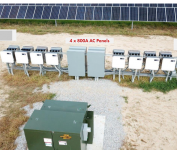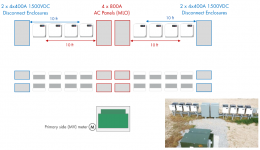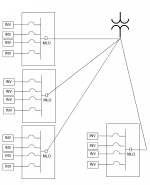I've seen this image (or one very much like it) multiple times before. I'm trying to understand the code compliance, implications, and options with it. Specifically with the transformer secondary conductors and their protection.
Assume they're all 125kW string inverters. So the inverters (16x125kw = 2MW) aren't greater than the transformer (2MVA) rating. Because of 690 and 705, I don't need secondary transformer protection. But there's still the secondary condcutor protection requirements in 240.21(C), and then 408.36 if it's a panelboard and not a switchboard.
The only option that seems to make sense to allow multiple circuits off the secondary like this is the 240.21(C)(2), but that's limited to 10ft conductors, and there's no way these conductors in the picture would be less than 10ft when you go through the conduit path.
Or perhaps I'm reading that section entirely wrong, and when 240.21(C)(4), outside conductors, says that it needs to land on a single OCPD, it really only means that this set of conductors need to land on a single OCPD. The conductors to the other 3 panels are irrelevant and treated separately. As long as each set lands on a single OCPD that aligns with 240.21(C)(4), then you're good. Is it as simple as that?
I've even seen some places show these panels being MLO, and I'm not sure how that is able to fly. Maybe the "industrial installation" clause in 240.21(C)(3), but it would require full size secondary conductors to each panel, which could be problematic with lug connections there. 2500A+ conductors landing in 800A panel... and then there's also 408.36 panelboard protection issue. Right?

Assume they're all 125kW string inverters. So the inverters (16x125kw = 2MW) aren't greater than the transformer (2MVA) rating. Because of 690 and 705, I don't need secondary transformer protection. But there's still the secondary condcutor protection requirements in 240.21(C), and then 408.36 if it's a panelboard and not a switchboard.
The only option that seems to make sense to allow multiple circuits off the secondary like this is the 240.21(C)(2), but that's limited to 10ft conductors, and there's no way these conductors in the picture would be less than 10ft when you go through the conduit path.
Or perhaps I'm reading that section entirely wrong, and when 240.21(C)(4), outside conductors, says that it needs to land on a single OCPD, it really only means that this set of conductors need to land on a single OCPD. The conductors to the other 3 panels are irrelevant and treated separately. As long as each set lands on a single OCPD that aligns with 240.21(C)(4), then you're good. Is it as simple as that?
I've even seen some places show these panels being MLO, and I'm not sure how that is able to fly. Maybe the "industrial installation" clause in 240.21(C)(3), but it would require full size secondary conductors to each panel, which could be problematic with lug connections there. 2500A+ conductors landing in 800A panel... and then there's also 408.36 panelboard protection issue. Right?




